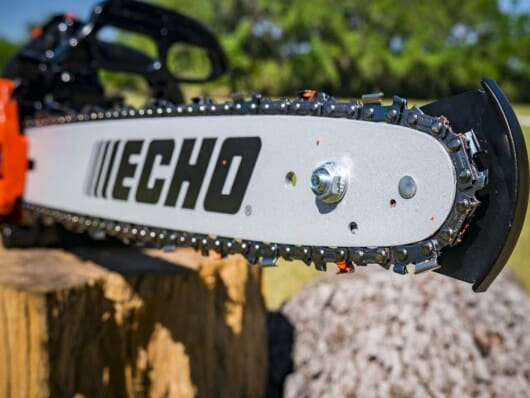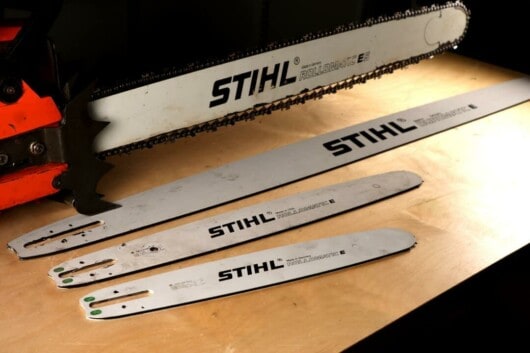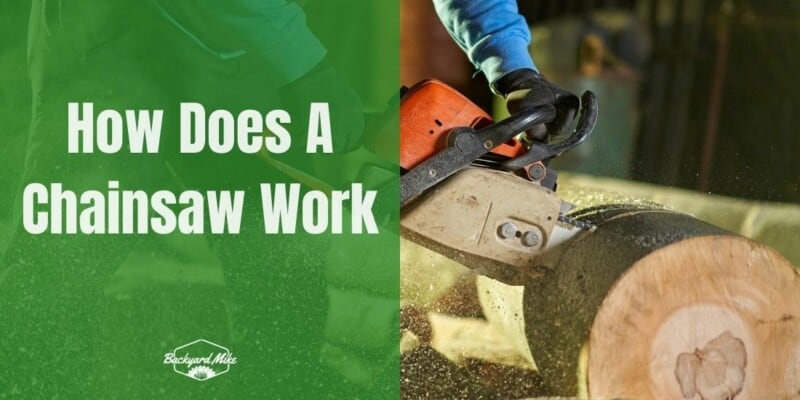Do you feel fascinated by the wonderful tool that is a chainsaw? Have you ever wondered how does a chainsaw work? If yes, then you’re in for a treat! In this article, you will get to know the technical side of a chainsaw’s working mechanism.
Essentially, a chainsaw converts chemical energy into mechanical energy, allowing you to easily cut trees and trim bushes. Continue reading to know how exactly the entire process happens and what roles do different chainsaw components play.
A simplified explanation of how does a chainsaw work
As mentioned above, a chainsaw works, in scientific terms, by converting the chemical energy of the gas/electrical energy of a power source into mechanical energy. This conversion of energy will allow you to do tasks like cutting trees, branches, pruning, trimming bushes, and more.
- You’ll need to add fuel to the chainsaw’s gas tank. This fuel, in its chemical form, will contain the energy that gets consumed when cutting down trees or trimming bushes. A typical chainsaw tank is capable of holding around 0.5 liters of gas.
- The fuel will feed through a carburetor and mix with the air.
- The mixture will then pass into a cylinder, which will work similarly to a car engine. It will utilize a simple 2-stroke (push-pull action) instead of the 4-stroke cycle used in cars. Inside the cylinder, the air-fuel mixture gets ignited by the spark plug. It burns, releases the energy, and pushes the piston back and forth. The piston in the engine features a bore (diameter) of around 45 mm (1.75-inch) and a stroke of around 33 mm (1.3-inches). It is under half the size of what you have in a car engine’s pistons, and also moves half as far.
- A connecting rod and crank will convert the back and forth motion in the piston into a rotary motion.
- A drive shaft will take the power to the centrifugal clutch.
- A chainsaw engine is capable of running all the time. However, you wouldn’t want the chain to spin unless you are cutting the wood. This is extremely dangerous and will waste a lot of energy. The clutch can solve this issue. The centrifugal clutch will connect the engine and the chain, once the engine speed is fast. It’ll stop the chain from spinning if the engine speed is low (when the chainsaw is idling).
- The gears will carry the power from the clutch to the sprocket holding the chain.
- The chain will spin around the edges of the guide bar and spit out the wood dust while cutting.
Centrifugal force – The key to a working chainsaw
The clutch is one of the most important components of a working chainsaw. It is a device that will make and release the mechanical connection in the chainsaw’s engine. A clutch can be considered a switch that allows the engine to run all the time (if the engine speed is fast). Otherwise, it’ll keep the engine in a working condition but without running (if the engine is idle).
In a chainsaw, the clutch will make it possible for you to keep the engine running at all times and disengage the chain. This will make it stay safe when it is motionless and not being used. All chainsaws use a centrifugal clutch, which will automatically engage when the engine is spinning at a high speed. It comes into play when you’re cutting trees, chopping wood, or trimming bushes.
Meanwhile, it’ll simply disengage when running slowly (or idling). A clutch consists of a few parts including – an inner drive shaft and an outer rim around it. In between, there are mechanical arms that are connected to the inner shaft. It’ll fly outward at high speed by utilizing centrifugal force. This will also lock the inner and outer components of the clutch.
The roles different chainsaw components play in its working
Engines and motors
Gas-powered chainsaws are started by pulling the starter cord that turns the crankshaft. This will move the piston in and out of the combustion chamber. In the combustion chamber, as the piston rises, it’ll compress the fuel. The spark plug will create sparks and the fuel will ignite. The combustion will push the piston downward and allow the exhaust gases to escape. This is done while forcing some of the fuel-air mixture from the crankcase and into the combustion chamber.
Once it is done, another new cycle will begin. At full throttle, a chainsaw engine will run from anywhere between 6,000 and 14,500 revolutions per minute. Electric-powered chainsaws will have a standard electric or a battery-operator motor to power the chain.
Chain
Small teeth on the chainsaw chain will help you carry out the cutting action. The chain will travel around the steel guide bar. The chain is constructed using three strands of hardened links. They’re riveted together for forming one continuous loop. The middle strand consists of a series of drive links with hook-shaped bottom edges. These edges will fit into the slot alongside the edges of the guide bar. The thickness of the drive links is known as the chain gauge.
Most homeowner chainsaws generally have a 0.050-inch gauge chain. The hooks on the bottom of the drive links will engage the teeth in the drive sprocket, so it’ll be their job to move of chain along the course. The middle strand is sandwiched by strands of steel that include cutters, spacers, and tie straps holding the chain together.

Every other cutter will be sharpened in the opposite direction. The distance from the outside of the left-hand cutter to the right-hand cutter determines the width of the cut. The other important chain measurement is called the pitch. It is measured with a caliper spanning three rivets, now divide the measurement by two. The majority of homeowner chainsaws come with a 3/8 pitch chain.
All chainsaw chains cuts will have a rocking motion. As the cutter is entering the wood, the leading edge will start biting. This will cause the cutter to go as far back as the depth gauge permits. The cutter then gets into an attacking position and jumps off the guide bar and into the wood. The tension and power from the chainsaw will pull the cutter back out of the wood. The severed wooden chips will exit from the underside of the cutter. The cutter will then return to its original position.
There are two very important parts of a cutter tooth. First, it’ll be the cutting edge. Just as important will be the depth gauge. The depth guide is the well-rounded forward edge. It’ll sit in front of the cutting and determine how far the cutter rocks back in position. It also determines how large of a bite the cutter takes.
The top of the depth gauge needs to be lower than the cutting edge. If it isn’t, the cutter won’t be able to take bites successfully. Similarly, if the depth gauge is too low, the rocking motion will be extremely rough. This forces the cutter to take an oversized bite. The cutter will grab the wood and the engine may stall, or even the chain could break. It could lead to potential kickback. It is important that you should keep the leading edge sharp.
Guide bar
The guide bar will guide the chain such that it can do the cutting properly. The bars are either made up of a solid piece of hardened steel or constructed using three laminated pieces.

The nose of the guide bar will be the rounded area where the chain reverses before returning to the drive sprocket. The tip could be solid with Stellite and welded on to reduce wear, or it could have a sprocket for further reducing bar tip wear. As touching the tip to the wood could cause kickback, a few manufacturers make a specially covered tip guard. A slot will go all the way around the bar. The drive links in the chain are used here, which means the thin sides of the slot are subject to wear.
Oil pump
The rivets, the drive links, and the guide bar will require constant lubrication. This is the job of the oil pump. Many chainsaws today come with an automatic lubrication pumping system. For older or smaller chainsaws, oiling needs to be activated through a bump that you can work with your thumb. No matter which system your chainsaw has, the oil will be pumped onto the chain and guide bar through a hole in the guide bar. It is essential to periodically remove the sprocket cover and ensure that the hole is clean of any debris.
Chain brakes
Any talk of how does a chainsaw work will be incomplete without mentioning the brakes. Chainsaws today come with two different kinds of brakes – a manual and an inertial brake. The front handguard will act as a manual brake with a trigger, similar to a hand pistol. With even slight pressure on the back of the handguard, a powerful spring mechanism will go off. It will clinch a binder strap on the drum attached to the chain drive sprocket. The chain will be seized almost immediately. It’ll happen within a matter of milliseconds.
The inertial brake is built into the front handle/manual brake senses the rotational motion of the chainsaw. It also sets off the linkage that stops the chain automatically. It is so quick that you won’t even need to think about doing this yourself. It’ll be similar to an airbag in a car, waiting to be used and prevent injuries.
Conclusion
Thank you for reading the article. Hopefully, now you’ll have enough information about the different components of a chainsaw and how does a chainsaw work. It always helps to know about chainsaw operation and maintenance, as you can never be too careful when handling it. With the explanation of how your chainsaw works, put it to good use, and remember to follow all safety protocols.


